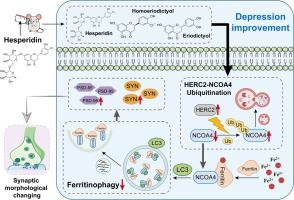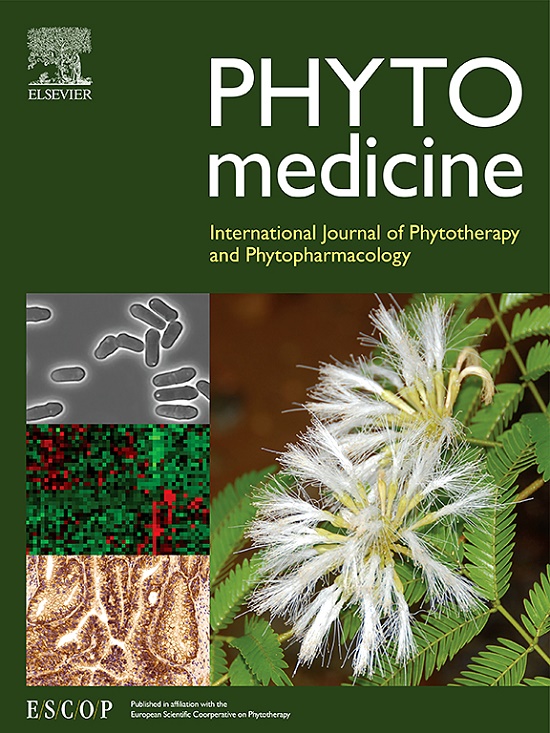Hesperidin alleviated dendritic spines through inhibiting ferritinophagy via HERC2-NCOA4 ubiquitination in CUMS mice
IF 6.7
1区 医学
Q1 CHEMISTRY, MEDICINAL
引用次数: 0
Abstract
Background
Depression has been linked to ferritinophagy-induced synaptic damage, which affects the emotional circuitry and can ultimately lead to depressive symptoms. It has been suggested that Hesperidin might improve depression disorders. However, the relationship between the therapeutic effects of the sympathetic nervous system in alleviating depression-like behaviors and ferritinophagy is still unknown.
Purpose
The objective of this study is to investigate the possible impact of Hesperidin in alleviating dendritic spines through the inhibition of ferritinophagy via HERC2-NCOA4 ubiquitination in mice exposed to chronic unpredictable mild stress (CUMS).
Methods
C57BL/6 and NCOA4+/+ mice were exposed to CUMS for 42 days. During the last 3 weeks of the CUMS procedure, the mice were administered Hesperidin (50, 100, 200 g/kg/d) or fluoxetine (10 mg/kg/d) once daily. Following the behavioral tests, Golgi staining, tissue iron concentration test, and perls staining were conducted to assess the therapeutic effect of Hesperidin. Additionally, ultrahigh-performance liquid chromatography-high-resolution tandem mass spectrometry (UPLC-Q-TOF/MS) and ultrahigh-performance liquid chromatography tandem mass spectrometry (UPLC-MS/MS) was utilized to analyze the metabolic components of Hesperidin in both blood and brain tissue. To investigate mechanism of Hesperidin, the cells were subjected to different concentrations of Hesperidin (25, 50, 100 µM), its metabolites (Eriodictyol (10, 20, 50 µM), Homoeriodictyol (0.1, 0.5, 1 µM)) and si-HERC2. Furthermore, HERC2-NCOA4 ubiquitination, and ferritinophagy-related proteins was explored through techniques such as western blot, immunofluorescence, co-immunoprecipitation, and molecular docking.
Results
Hesperidin has demonstrated the potential to alleviate symptoms of depression by regulating dendritic spines through the inhibition of NCOA4-ferritinophagy, while NCOA4 overexpression could reverse these results. Importantly, the content of Hesperidin metabolites (Homoeriodictyol and Eriodictyol) was relatively high in brain tissue. The Hesperidin and its metabolites, Eriodictyol and Homoeriodictyol, were able to regulate GluR2 and SYN protein expression. Additionally, they inhibited ferritinophagy involving NCOA4, P62, LC3, and FTH. but this phenomenon was reversed by si-HERC2 following Hesperidin and its metabolite administration. Furthermore, the binding of HERC2 and NCOA4 protein was found to be inhibited by Hesperidin and its metabolites.
Conclusions
Hesperidin alleviated dendritic spines through inhibiting ferritinophagy via HERC2-NCOA4 ubiquitination in CUMS mice.

橙皮甙通过HERC2-NCOA4泛素化抑制铁蛋白吞噬作用,从而缓解CUMS小鼠的树突棘。
背景:抑郁症与嗜铁蛋白诱导的突触损伤有关,这种损伤会影响情感回路,并最终导致抑郁症状。有人认为橙皮甙可能会改善抑郁症。目的:本研究旨在探讨橙皮甙通过HERC2-NCOA4泛素化抑制铁蛋白吞噬对暴露于慢性不可预测轻度应激(CUMS)的小鼠树突棘可能产生的影响:方法:将 C57BL/6 和 NCOA4+/+ 小鼠暴露于 CUMS 42 天。在CUMS过程的最后3周,给小鼠服用橙皮甙(50、100、200克/千克/天)或氟西汀(10毫克/千克/天),每天一次。行为测试后,进行高尔基体染色、组织铁浓度测试和过氧化物染色,以评估橙皮甙的治疗效果。此外,超高效液相色谱-高分辨串联质谱法(UPLC-Q-TOF/MS)和超高效液相色谱-串联质谱法(UPLC-MS/MS)分析了橙皮甙在血液和脑组织中的代谢成分。为了研究橙皮甙的作用机制,研究人员将细胞置于不同浓度的橙皮甙(25、50、100 µM)、其代谢产物(廿二烷醇(10、20、50 µM)、高碘烷醇(0.1、0.5、1 µM))和 si-HERC2 的作用下。此外,还通过 Western 印迹、免疫荧光、共免疫沉淀和分子对接等技术对 HERC2-NCOA4 泛素化和嗜铁蛋白相关蛋白进行了研究:结果表明:橙皮甙可通过抑制NCOA4-噬铁蛋白来调节树突棘,从而缓解抑郁症状,而NCOA4的过表达可逆转这些结果。重要的是,脑组织中橙皮甙代谢物(Homoeriodictyol和Eriodictyol)的含量相对较高。橙皮甙及其代谢物--廿二烷醇和高廿二烷醇能够调节 GluR2 和 SYN 蛋白的表达。此外,它们还抑制了涉及 NCOA4、P62、LC3 和 FTH 的铁蛋白吞噬作用,但在服用橙皮甙及其代谢物后,这种现象被 si-HERC2 逆转。此外,橙皮甙及其代谢物还抑制了HERC2和NCOA4蛋白的结合:结论:橙皮甙可通过HERC2-NCOA4泛素化抑制铁蛋白吞噬,从而缓解CUMS小鼠的树突棘。
本文章由计算机程序翻译,如有差异,请以英文原文为准。
求助全文
约1分钟内获得全文
求助全文
来源期刊

Phytomedicine
医学-药学
CiteScore
10.30
自引率
5.10%
发文量
670
审稿时长
91 days
期刊介绍:
Phytomedicine is a therapy-oriented journal that publishes innovative studies on the efficacy, safety, quality, and mechanisms of action of specified plant extracts, phytopharmaceuticals, and their isolated constituents. This includes clinical, pharmacological, pharmacokinetic, and toxicological studies of herbal medicinal products, preparations, and purified compounds with defined and consistent quality, ensuring reproducible pharmacological activity. Founded in 1994, Phytomedicine aims to focus and stimulate research in this field and establish internationally accepted scientific standards for pharmacological studies, proof of clinical efficacy, and safety of phytomedicines.
 求助内容:
求助内容: 应助结果提醒方式:
应助结果提醒方式:


